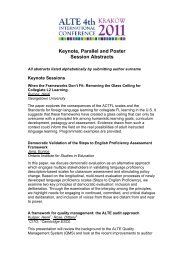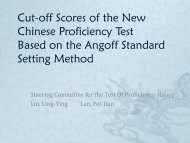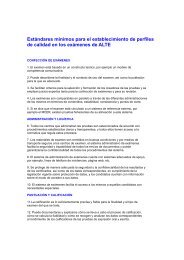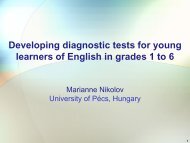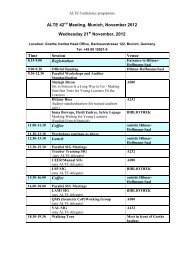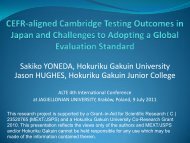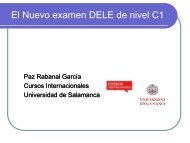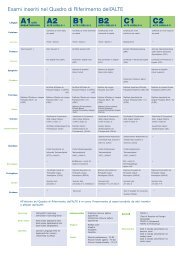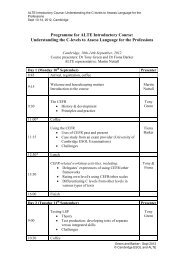The Effect of Dynamic Assessment on Students - ALTE
The Effect of Dynamic Assessment on Students - ALTE
The Effect of Dynamic Assessment on Students - ALTE
You also want an ePaper? Increase the reach of your titles
YUMPU automatically turns print PDFs into web optimized ePapers that Google loves.
<str<strong>on</strong>g>The</str<strong>on</strong>g> <str<strong>on</strong>g>Effect</str<strong>on</strong>g> <str<strong>on</strong>g>of</str<strong>on</strong>g> <str<strong>on</strong>g>Dynamic</str<strong>on</strong>g> <str<strong>on</strong>g>Assessment</str<strong>on</strong>g> <strong>on</strong><br />
<strong>Students</strong>' Performance in Oral EFL Tests<br />
Work in Progress<br />
<strong>ALTE</strong> 2011, Krakov<br />
Tzi<strong>on</strong>a Levi<br />
Tel Aviv University<br />
<str<strong>on</strong>g>The</str<strong>on</strong>g> study is c<strong>on</strong>ducted under the guidance <str<strong>on</strong>g>of</str<strong>on</strong>g><br />
Pr<str<strong>on</strong>g>of</str<strong>on</strong>g>. Elana Shohamy, , Tel Aviv University
Plan<br />
• Literature<br />
• Methodology<br />
• Initial findings
<str<strong>on</strong>g>Dynamic</str<strong>on</strong>g> <str<strong>on</strong>g>Assessment</str<strong>on</strong>g> (DA)<br />
• <str<strong>on</strong>g>The</str<strong>on</strong>g> inclusi<strong>on</strong> <str<strong>on</strong>g>of</str<strong>on</strong>g> the learning episode in the<br />
assessment procedure (Sternberg & Grigorenko,<br />
2002)<br />
• Derived from Vygotsky’s (1934/1986)<br />
sociocultural theory (SCT) that instructi<strong>on</strong> leads<br />
to development when pedagogical activities are<br />
redefined and tied to assessment.
• DA incorporates the results <str<strong>on</strong>g>of</str<strong>on</strong>g> an interventi<strong>on</strong><br />
into the assessment procedure in which learning<br />
can be observed in 'real time'.<br />
• <str<strong>on</strong>g>The</str<strong>on</strong>g> students take advantage <str<strong>on</strong>g>of</str<strong>on</strong>g> teacher-tester<br />
tester<br />
'mediati<strong>on</strong>' <str<strong>on</strong>g>of</str<strong>on</strong>g>fering more efficient learning<br />
strategies - optimizing match between students<br />
and tasks.<br />
(Haywood & Lidz, , 2007).
• DA is hypothesized to provide informati<strong>on</strong><br />
about learning potential rather than about<br />
student performance (Gillam, et al., 1999;<br />
2000).<br />
, et al., 1999; Tzuriel,<br />
• DA - derived from Vygotsky’s (1934/1986)<br />
ZPD and Feuerstein's structural cognitive<br />
modifiability (Feuerstein et. al., 1979).<br />
• Both c<strong>on</strong>cepts c<strong>on</strong>sider human abilities as<br />
flexible and 'modifiable' as opposed to the<br />
'fixed' attitude <str<strong>on</strong>g>of</str<strong>on</strong>g> the psychometric<br />
approach.
Much <str<strong>on</strong>g>of</str<strong>on</strong>g> the research <strong>on</strong> DA has<br />
dem<strong>on</strong>strated its usefulness mostly for<br />
1. students with special needs, in general<br />
cogniti<strong>on</strong><br />
cogniti<strong>on</strong> (e.g., Feuerstein et al., 1979; 1980; 1988; 2003),<br />
2. L1 (e.g., Guterman, , 2002; Peña et al., 2006; Spector, , 1992)<br />
3. L2 learning (e.g., Kosulin & Garb, 2002;<br />
& Garb, 2002; Poehner, , 2005).
DA vs. other forms <str<strong>on</strong>g>of</str<strong>on</strong>g> assessment<br />
• Teaching and <str<strong>on</strong>g>Assessment</str<strong>on</strong>g> viewed as<br />
separate issues.<br />
• Overlap between them is <str<strong>on</strong>g>of</str<strong>on</strong>g>ten<br />
regarded negatively (washback, teaching<br />
to the test, narrowing the curriculum).<br />
• Closer interface b/w assessment and<br />
teaching <strong>on</strong>ly for specific aims (Bachman<br />
& Cohen 1996) e.g. diagnostic assessment<br />
(Alders<strong>on</strong> 2006); interactive assessment<br />
(forthcoming in HK -Davis<strong>on</strong>, Hamp-Ly<strong>on</strong>s)<br />
<str<strong>on</strong>g>Assessment</str<strong>on</strong>g><br />
Teaching<br />
Poehner, , 2009
Testing & Classroom <str<strong>on</strong>g>Assessment</str<strong>on</strong>g>:<br />
Fundamental Differences<br />
• Discrete activity vs. <strong>on</strong>going opportunities to gather<br />
various kinds <str<strong>on</strong>g>of</str<strong>on</strong>g> info.<br />
• Other kinds <str<strong>on</strong>g>of</str<strong>on</strong>g> informati<strong>on</strong> vs. “scientific” tests<br />
• Aim <str<strong>on</strong>g>of</str<strong>on</strong>g> assessment – stable trait vs. emerging through<br />
collaborative performance.<br />
• <str<strong>on</strong>g>Assessment</str<strong>on</strong>g> outcomes – reducti<strong>on</strong> <str<strong>on</strong>g>of</str<strong>on</strong>g> performance<br />
complexity (percentile ranking, score) vs. sharing <str<strong>on</strong>g>of</str<strong>on</strong>g><br />
work (products & processes).<br />
Moss, 2003; Poehner, , 2009
From <str<strong>on</strong>g>Assessment</str<strong>on</strong>g> as Measurement to<br />
<str<strong>on</strong>g>Assessment</str<strong>on</strong>g> as Inquiry<br />
• Move from educati<strong>on</strong>al practice <str<strong>on</strong>g>of</str<strong>on</strong>g> assessment<br />
where we a priori define what we are looking<br />
for to better understand & transform<br />
informati<strong>on</strong>.<br />
• Move from state <str<strong>on</strong>g>of</str<strong>on</strong>g> having knowledge to<br />
desire for acti<strong>on</strong> involving participati<strong>on</strong>,<br />
transacti<strong>on</strong>, & transformati<strong>on</strong>.<br />
Delandshere, 2002:1475-1480
<str<strong>on</strong>g>Assessment</str<strong>on</strong>g> as Inquiry (c<strong>on</strong>t.)<br />
• Current assessment practices:<br />
What do students know?<br />
• Scores represent amount or level <str<strong>on</strong>g>of</str<strong>on</strong>g> knowledge<br />
• Early theories <str<strong>on</strong>g>of</str<strong>on</strong>g> learning (e.g. behaviorism)<br />
• Different theoretical perspective:<br />
not <strong>on</strong>ly What students know?<br />
but also How do they accomplish this task?<br />
Poehner, , 2009
DA & Formative <str<strong>on</strong>g>Assessment</str<strong>on</strong>g> (FA)<br />
DA aligns c<strong>on</strong>ceptually with FA relating to the use <str<strong>on</strong>g>of</str<strong>on</strong>g><br />
test data to influence the teaching/learning process<br />
to adapt to a variety <str<strong>on</strong>g>of</str<strong>on</strong>g> student learning needs (e.g.,<br />
<str<strong>on</strong>g>Assessment</str<strong>on</strong>g> Reform Group, 2002; Black & William, 1998; Leung,<br />
2004, 2005; Rea-Dickins<br />
Dickins, , 2001, 2006; William et al., 2004).<br />
Such as:<br />
• collecting informati<strong>on</strong> during the course <str<strong>on</strong>g>of</str<strong>on</strong>g> studies<br />
• engaging students in self-reflective processes (Black,<br />
et al., 2003)<br />
• aiding the planning and managing <str<strong>on</strong>g>of</str<strong>on</strong>g> less<strong>on</strong>s<br />
• generating evidence to evaluate teaching<br />
• providing evidence <str<strong>on</strong>g>of</str<strong>on</strong>g> student learning
DA & <str<strong>on</strong>g>Assessment</str<strong>on</strong>g> for Learning<br />
• A vehicle for improvement <str<strong>on</strong>g>of</str<strong>on</strong>g> teaching and<br />
learning processes (Leung, 2007) for directing and<br />
driving student learning by alignment between<br />
instructi<strong>on</strong> and assessment.<br />
, 1997- Individual assessment<br />
preferences overshadow disciplinary group<br />
differences and impact student learning strategies.<br />
• Showing the need for a dialogue between<br />
instructors and students to structure expectati<strong>on</strong>s<br />
regarding learning needs.<br />
• Eg. Birenbuam, 1997
Integrating <str<strong>on</strong>g>Assessment</str<strong>on</strong>g> & Teaching?<br />
• Can a single activity be used for both<br />
evaluative and instructi<strong>on</strong>al purposes?<br />
• Is the focus <strong>on</strong> the “teaching event” or <strong>on</strong> the<br />
“assessment event”?<br />
• How can we design tasks that perform dual<br />
functi<strong>on</strong>?<br />
• How does <strong>on</strong>e approach interacti<strong>on</strong>s with<br />
learners?<br />
<str<strong>on</strong>g>Assessment</str<strong>on</strong>g>-Teaching
Current study<br />
• Affixing DA to OLP fits Vygotsky's theories that there is<br />
a gap between actual and potential student performance.<br />
• <str<strong>on</strong>g>The</str<strong>on</strong>g> analysis <str<strong>on</strong>g>of</str<strong>on</strong>g> this gap, known as the Z<strong>on</strong>e <str<strong>on</strong>g>of</str<strong>on</strong>g> Proximal<br />
Development (ZPD), allows interpreting what the<br />
student can do in interacti<strong>on</strong> with a competent adult.<br />
• Types <str<strong>on</strong>g>of</str<strong>on</strong>g> mediati<strong>on</strong> in DA differ in method, but<br />
incorporate a training period between pre-and post-tests<br />
tests<br />
and apply self-regulati<strong>on</strong> models.<br />
Lantolf & Thr<strong>on</strong>e, 2006; Guterman, , 2002
DA and oral tests<br />
• C<strong>on</strong>trolled interacti<strong>on</strong> or a 'collaborative<br />
dialogue' (Swain, 2000) through prompting<br />
test-takers takers and/or applying metacognitive<br />
tools, may amplify oral language learning<br />
and result in improved oral performance<br />
within the c<strong>on</strong>text <str<strong>on</strong>g>of</str<strong>on</strong>g> a foreign language<br />
oral test.
Studying OLP<br />
• Vygotskian perspective suggests occurrence <str<strong>on</strong>g>of</str<strong>on</strong>g><br />
learning when dialogic communicati<strong>on</strong> between<br />
two or more individuals takes place (Ahmed,<br />
1994)<br />
• Dialogic nature <str<strong>on</strong>g>of</str<strong>on</strong>g> OLP tests make them suitable<br />
for tester prompts relayed as mediati<strong>on</strong> -<br />
providing specific means to enhance learning.
Rati<strong>on</strong>ale: Current study<br />
• Linking DA with academic achievements:<br />
highly active area <str<strong>on</strong>g>of</str<strong>on</strong>g> development and<br />
research.<br />
• If DA is to be useful in educati<strong>on</strong>al settings,<br />
it must c<strong>on</strong>tribute to academic<br />
achievements.<br />
DA<br />
Oral achievements
Research questi<strong>on</strong>s<br />
1. To what extent will DA mediati<strong>on</strong> affect results <str<strong>on</strong>g>of</str<strong>on</strong>g><br />
an OLP test setting?<br />
2. If OLP scores improve as a result <str<strong>on</strong>g>of</str<strong>on</strong>g> mediati<strong>on</strong>,<br />
which can it be attributed to: external mediati<strong>on</strong><br />
provided by a group or self-m<strong>on</strong>itored mediati<strong>on</strong>?<br />
(Both supported by a teacher tester)<br />
3. If changes in scores occur as a result <str<strong>on</strong>g>of</str<strong>on</strong>g> DA<br />
mediati<strong>on</strong>, what areas <str<strong>on</strong>g>of</str<strong>on</strong>g> OLP are affected most?
Pilot: video-recorded observati<strong>on</strong>s<br />
• Aim: to identify the c<strong>on</strong>tent and format <str<strong>on</strong>g>of</str<strong>on</strong>g><br />
OLP that is most suitable for effective<br />
mediati<strong>on</strong> and design the research plan.<br />
• to examine OLP characteristics, while<br />
validating Israeli Ministry <str<strong>on</strong>g>of</str<strong>on</strong>g> Educati<strong>on</strong> oral<br />
rubrics through expert analysis.
Research design<br />
• 73: 11-grade students; from comprehensive HS sharing<br />
assessment practices and SES features.<br />
• Pre- and post- OLP tests. (recordings)<br />
• Treatment group 1: group-mediati<strong>on</strong> guided by a teacher-<br />
tester.<br />
• Treatment group 2: 'self-mediati<strong>on</strong>' relating to the same<br />
elements and criteria as in the group- mediati<strong>on</strong>.<br />
• C<strong>on</strong>trol group 3: No mediati<strong>on</strong>.<br />
• To avoid pre-teaching towards post-test, test, teachers and<br />
students were randomly mixed when re-tested.<br />
Identical mediati<strong>on</strong> groups
Design (c<strong>on</strong>t.)<br />
• Quantitative analysis <str<strong>on</strong>g>of</str<strong>on</strong>g> scores comparing pre<br />
and post-test test results.<br />
• Audio recordings <str<strong>on</strong>g>of</str<strong>on</strong>g> mediati<strong>on</strong> sessi<strong>on</strong>s were<br />
analyzed qualitatively to gain in-depth depth insights<br />
<str<strong>on</strong>g>of</str<strong>on</strong>g> the learning process between tests and as a<br />
result <str<strong>on</strong>g>of</str<strong>on</strong>g> mediati<strong>on</strong>.
Mediati<strong>on</strong>:<br />
SCOBA<br />
and<br />
Rubrics<br />
• Systemic-Cognitive Instructi<strong>on</strong>al Approach<br />
to help learners internalize scientific<br />
c<strong>on</strong>cepts. (1) the units <str<strong>on</strong>g>of</str<strong>on</strong>g> instructi<strong>on</strong>, (2)<br />
materialized, and (3) verbalized both<br />
externally and internally by the learner to<br />
promote internalizati<strong>on</strong>.<br />
a) a diagnostic pre-test<br />
b) c<strong>on</strong>tent coverage <str<strong>on</strong>g>of</str<strong>on</strong>g> the OLP test applying<br />
the rubrics<br />
c) taking advantage <str<strong>on</strong>g>of</str<strong>on</strong>g> instructi<strong>on</strong>al quality<br />
and time using the SCOBA to create student<br />
engagement.<br />
.
Mediati<strong>on</strong>: SCOBA (c<strong>on</strong>t.)<br />
1. Introducing the (scientific) c<strong>on</strong>cept <str<strong>on</strong>g>of</str<strong>on</strong>g> the OLP and<br />
pers<strong>on</strong>al orientati<strong>on</strong> <str<strong>on</strong>g>of</str<strong>on</strong>g> goal-setting to be c<strong>on</strong>ferred by<br />
examining the videotape <str<strong>on</strong>g>of</str<strong>on</strong>g> students’ performance.<br />
2. Applying the tool within a treatment group through<br />
self-m<strong>on</strong>itoring.<br />
3. Casual communicati<strong>on</strong> and interacti<strong>on</strong> about their<br />
performance as examined in their own videotape.<br />
4. Verbalizing and summarizing the points learned.
Results:<br />
(RQ 1,2)<br />
CA<br />
18<br />
16<br />
Figure 1: Comparis<strong>on</strong> <str<strong>on</strong>g>of</str<strong>on</strong>g><br />
CA score (mean) between<br />
pre- and post- tests<br />
Group-Mediati<strong>on</strong><br />
Self-Mediati<strong>on</strong><br />
C<strong>on</strong>trol Group<br />
14<br />
12<br />
10<br />
8<br />
Pretest<br />
Posttest<br />
6<br />
• Significant differences were found<br />
between mediati<strong>on</strong> groups for both<br />
measures <str<strong>on</strong>g>of</str<strong>on</strong>g> Communicative Ability<br />
and Accuracy.
Results:<br />
(RQ 1,2)<br />
• Improvement in the<br />
two mediati<strong>on</strong> groups<br />
for both measures <str<strong>on</strong>g>of</str<strong>on</strong>g><br />
OLP scores in<br />
comparis<strong>on</strong> to<br />
the c<strong>on</strong>trol<br />
group.<br />
Group-Mediati<strong>on</strong><br />
Self-Mediati<strong>on</strong><br />
C<strong>on</strong>trol Group<br />
Figure 2: Comparis<strong>on</strong> <str<strong>on</strong>g>of</str<strong>on</strong>g><br />
Accuracy score (mean)<br />
between pre- and post- tests.<br />
Accuracy<br />
16<br />
14<br />
12<br />
10<br />
Pretest<br />
Posttest<br />
8<br />
6
CA<br />
A follow-up test<br />
20<br />
18<br />
Self-Mediati<strong>on</strong><br />
• Two weeks later-<br />
Group-Mediati<strong>on</strong><br />
C<strong>on</strong>trol Group<br />
16<br />
14<br />
Pretest<br />
Posttest<br />
Follow -up test<br />
12<br />
Did mediati<strong>on</strong><br />
program retain its<br />
effect?<br />
Self-Mediati<strong>on</strong><br />
Accuracy<br />
20<br />
18<br />
Group-Mediati<strong>on</strong><br />
16<br />
C<strong>on</strong>trol Group<br />
14<br />
Prestest<br />
Posttest<br />
Follow -up test<br />
12
RQ 3: 3 Structured observati<strong>on</strong>s <str<strong>on</strong>g>of</str<strong>on</strong>g> oral<br />
interacti<strong>on</strong> in mediati<strong>on</strong>: sample categories<br />
Category clusters<br />
Classificati<strong>on</strong><br />
Relating to<br />
others’ ideas<br />
Categories<br />
1.1. Seeking clarificati<strong>on</strong><br />
1.2. Giving clarificati<strong>on</strong><br />
1.3. Expressing miscomprehensi<strong>on</strong><br />
1.4 Trying to understand<br />
1.5 Seeking c<strong>on</strong>firmati<strong>on</strong><br />
2.1. Expressing agreement<br />
2.2. Disagreeing<br />
2.3. Incorporating ideas & elaborating<br />
2.4. Approving<br />
2.5. Resp<strong>on</strong>ding to prompt/Eliciting a<br />
resp<strong>on</strong>se<br />
2.6. Eliciting an elaborati<strong>on</strong><br />
2.7 Restricting
RQ 3: 3 Cluster categories <str<strong>on</strong>g>of</str<strong>on</strong>g> oral<br />
performance qualitative data (C<strong>on</strong>t.)<br />
Importance <str<strong>on</strong>g>of</str<strong>on</strong>g> category in testee statements in %<br />
Clarificati<strong>on</strong><br />
14%<br />
12%<br />
Relating to others’ ideas<br />
Expressing emoti<strong>on</strong>s<br />
Process-related<br />
commentary<br />
21%<br />
22%<br />
Typically teacher-related<br />
categories<br />
Taking charge <str<strong>on</strong>g>of</str<strong>on</strong>g><br />
interacti<strong>on</strong><br />
26%<br />
6%
Student interacti<strong>on</strong>s<br />
Modifiability scale and learner strategies’<br />
checklist (Pena, 2000; Brooks et. Al., 2009),<br />
adapted to examine student interacti<strong>on</strong>s.
Student interacti<strong>on</strong>: Findings<br />
Significant differences in all measures besides<br />
Attenti<strong>on</strong> between individual and group-mediati<strong>on</strong>.<br />
Group-<br />
Mediati<strong>on</strong><br />
Self-Mediati<strong>on</strong><br />
M<br />
SD<br />
M<br />
SD<br />
F(1,42)<br />
Eta 2<br />
Attenti<strong>on</strong><br />
1.58<br />
.32<br />
1.62<br />
.48<br />
.11<br />
.00<br />
Planning<br />
1.53<br />
.25<br />
.73<br />
.56<br />
38.52***<br />
.48<br />
Regulati<strong>on</strong><br />
1.14<br />
.40<br />
.77<br />
.52<br />
13.35*<br />
.15<br />
Transfer<br />
1.42<br />
.39<br />
.26<br />
.39<br />
93.64***<br />
.69<br />
Motivati<strong>on</strong><br />
1.30<br />
.48<br />
.60<br />
.39<br />
26.77***<br />
.39<br />
Dialoguing<br />
1.54<br />
.12<br />
.66<br />
.44<br />
87.14***<br />
.68<br />
Languaging<br />
.70<br />
.47<br />
.28<br />
.13<br />
10.44**<br />
.26
Results (RQ 3):<br />
• Group: : more supportive <str<strong>on</strong>g>of</str<strong>on</strong>g> learning<br />
than individual self-reflective learning.<br />
• Individual students: while reflecting are<br />
more critical towards themselves and<br />
what is lacking. Very few expressed<br />
even limited satisfacti<strong>on</strong>.
Implicati<strong>on</strong>s and plans for further data<br />
analysis<br />
• Interviewer active as partner in dialogue<br />
prompting, elaborating, initiating.<br />
• Number <str<strong>on</strong>g>of</str<strong>on</strong>g> exchanges in interventi<strong>on</strong> groups.<br />
• <strong>Students</strong> spoke about speaking mostly using L1.<br />
L1 is used to think about and promote L2.<br />
• Interviewer and participant's roles in dialogue<br />
get blurred as they all c<strong>on</strong>tribute to the growth<br />
<str<strong>on</strong>g>of</str<strong>on</strong>g> meaning thus creating a GZPD.
Thank you for your attenti<strong>on</strong><br />
z_levi@netvisi<strong>on</strong>.net.il




